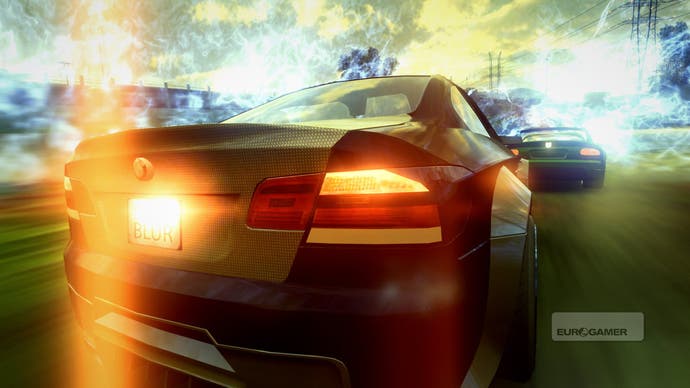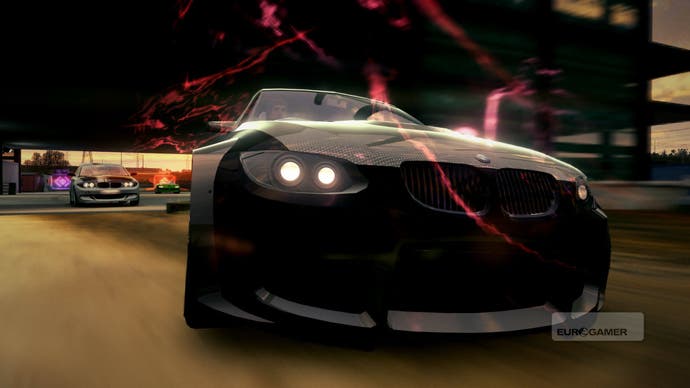Blur
Power-up to the people.
But the defining location at the moment seems to be London, or rather Hackney. Its backbone is a real stretch of the A10 (you race past Shoreditch Church and the Tea Building, and spot the Gherkin squatting in the skyline) but the surrounding chunks of Old Street, Dalston and Hoxton have been rearranged at Bizzare's whim into a shape that suits the fast, open track (rather than the Gotham method of coaxing good corners out of a tight, verbatim street plan). There are painstaking recreations of hideously ugly boarded-up council blocks. The tone is scruffy, cool, but also dangerous, low-rent and a bit, for want of a better word, chav.
That's more or less reflected in the selection of cars. The mainstays seem to be US muscle cars - Dodge Challenger, Mustang, Chevy Camaro - and Japanese and European street-racer favourites like the Nissan 350Z, Mistubishi Evo, BMW 1-series coupé and Focus RS. We also spot (although licensing isn't confirmed) a heavily modified vintage VW Beetle and a 1990s Ford Transit van with a Formula One engine in it. Representing off-roaders is that magnificent Range Rover on steroids, the Bowler Nemesis. It's a far broader range than even the pretty Catholic PGR2.
Bizarre says it wants to reflect more sides to street car culture than the rims and fins of the Fast and the Furious films. Wilfully beat-up "rat cars" and "smooth" culture - the art of eliminating all detail from a car's bodyshell to express the purity of its shape - are examples of two underground car scenes that nobody else is supporting, Bizarre reckons. Manufacturers have approved a series of special concepts especially for Blur, and allowed damage and even - for the first time - flames. "There have been a couple of big manufacturers, can't tell you who, that have gone, 'You can't set the cars on fire,' and we've gone, 'OK, we won't use your cars then,'" says Wilson. "Because the cars are not the star of the game, the gameplay is the star of the game."

Damage, of course, became a necessity when power-ups were brought into the equation. These are meant to have a less dramatic effect on the race than Mario Kart's, tipping the balance towards skill, but unlike Mario Kart your car does have structural health and can be fatally damaged if you don't drive through the repair icons. "I think in power and influence we're much closer to WipEout," says Wilson. "They certainly influence the race, and when you play harder difficulties you can't win those races without using power-ups, but they're not as random or as final as some of the Mario Kart ones are."
Shock emits an area-of-effect EMP pulse that slows the target car (your current target is indicated with a pillar of light) and others near it down. Shunt targets a car in front and pushes it left or right depending where you aim from, best used to send opponents into the wall on corners. Barge sends waves of force out of the sides of your car, slamming rivals into the scenery or each other. Shield, Mine and Boost are self-explanatory. They're picked up off the track in classic style, although you can always see what you're getting and aim for a particular power-up.
Tuning the effect and presentation of these power-ups so they pack a punch without destroying the balance of the race isn't going to be easy and Bizarre still has some way to go. At the moment, they feel a little weak, which is partly down to their non-physical fantasy presentation, although beefy, bassy sound effects help. Barge is the most original, and also the most fun.

Handling initially lacks involvement too, but once a Gotham veteran gets into a drift car like the Challenger and steps the back end out they'll know that the magic is still there. As is the full physics engine; this isn't just arcade contrivance. "Burnout doesn't really have a proper physics engine in the same way," says Wilson. "This is still a proper physics engine... We're not dumbing down at all." While the handling has been simplified, a lot of the physical interest will come from the simulation of varied surfaces and the weight of the destructible track furniture - neither feature was in the build we played.
So far, Blur is looking like a solid arcade racer, bolstered by an unerringly cool car collection and some evocative locations and lighting (the game always takes place in the semi-dark to pick out the neon effects of the power-ups, and the lasers and glow-sticks of the crowd, who are apparently all nineties ravers). But Bizarre, being Bizarre, has a trick up its sleeve.


